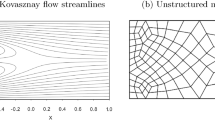Abstract
A two-time-level, three-dimensional numerical ocean circulation model is established with a two-level, single-step Eulerian time-difference scheme. The mathematical model of the large-scale oceanic motions is based on the terrain-following coordinated, Boussinesq, Reynolds-averaged primitive equations of ocean dynamics. A simple but very practical Eulerian forward-backward method is adopted to replace the most preferred leapfrog scheme as the time-difference method for both barotropic and baroclinic modes. The forward-backward method is of the second order of accuracy, requires only once of the function evaluation per time step, and is free of the computational mode inherent in the three-level schemes. It is superior in many respects to the original leapfrog and Asselin-filtered leapfrog schemes in the practical use. The performance of the newly-built circulation model is tested by simulating a barotropic (tides in marginal seas of China) and a baroclinic phenomenon (seasonal evolution of the Yellow Sea Cold Water Mass), respectively. The three-year time histories of four prognostic variables obtained by the POM model and the two-time-level model are compared in a regional simulation experiment for the northwest Pacific to further show the reliability of the two-level scheme circulation model.
Similar content being viewed by others
References
KANTHA L. H., CLAYSON C. A. Numerical models of oceans and oceanic processes[M]. Waltham, Massachusetts, USA: Academic Press, 2000.
CHEN C., LIU H. and BEARDSLEY R. C. An unstructured grid, finite-volume, three-dimensional, primitive equations ocean model: Application to coastal ocean and estuaries[J]. Journal Atmospheric and Oceanic Technology, 2003, 20(1): 159–186.
CHEN C., BEARDSLEY R. C. and COWLES G. An unstructured grid, finite-volume coastal ocean model (FVCOM) system[J]. Oceanography, 2006, 19(1): 78–89.
HAIDVOGEL D. B., ARANGO H. and BUDGELL W. P. et al. Ocean forecasting in terrain-following coordinates: Formulation and skill assessment of the regional ocean modeling system[J]. Journal of Computational Physics, 2008, 227(7): 3595–3624.
DURRAN D. R. Numerical methods for wave equations in geophysical fluid dynamics[M]. New York, USA: Springer, 1999.
MARSALEIX P., AUCLAIR F. and DUHAUT T. et al. Alternatives to the Robert-Asselin filter[J]. Ocean Modelling, 2012, 41: 53–66.
ZHAO B., ZHONG Q. An alternative method to leapfrog time differencing and its applications in an atmospheric general circulation model[J]. Climatic and Environmental Research, 2009, 14(1): 21–30.
SUN W.-Y. Instability in leapfrog and forward-backward schemes[J]. Monthly Weather Review, 2010, 138(5): 1497–1501.
MELLOR G. L. Users guide for a three-dimensional, primitive equation, numerical ocean model[M]. Princeton, New Jersey, USA: Atmospheric and Oceanic Sciences Program, Princeton University, 2003.
QIAO F., YUAN Y. and YANG Y. et al. Wave-induced mixing in the upper ocean: Distribution and application in a global ocean circulation model[J]. Geophysical Research Letter, 2004, 31(11): L11303.
SUN W.-Y. Instability in leapfrog and forward-backward schemes Part II: Numerical simulations of dam break[J]. Computers and Fluids, 2011, 45(1): 70–76.
SHCHEPETKIN A. F., MCWILLIAMS J. C. The regional ocean modeling system: A split-explicit, freesurface, topography following coordinates ocean model[J]. Ocean Modelling, 2005, 9(4): 347–404.
XIA C., QIAO F. and YANG Y. et al. Three-dimensional structure of the summertime circulation in the Yellow Sea from a wave-tide-circulation coupled model[J]. Journal of Geophysical Research, 2006, 111(C11): C11S03.
FANG G., WANG Y. and WEI Z. et al. Empirical cotidal charts of the Bohai, Yellow, and East China Seas from 10 years of TOPEX/Poseidon altimetry[J]. Journal of Geophysical Research, 2004, 109(C11): C11006.
PARK S., CHU P. C. and LEE J.-H. Interannual-to-interdecadal variability of the Yellow Sea Cold Water Mass in 1967-2008: Characteristics and seasonal forcings[J]. Journal of Marine System, 2011, 87(3-4): 177–193.
Author information
Authors and Affiliations
Corresponding author
Additional information
Project supported by the National Science Foundation of China (Grant No. 40906017, 41376038), the National High Technology Research and Development Program of China (863 Program, Grant No. 2013AA09A506).
Biography: HAN Lei (1981-), Male, Ph. D. Senior Engineer
Rights and permissions
About this article
Cite this article
Han, L., Yuan, Yl. An ocean circulation model based on Eulerian forward-backward difference scheme and three-dimensional, primitive equations and its application in regional simulations. J Hydrodyn 26, 37–49 (2014). https://doi.org/10.1016/S1001-6058(14)60005-6
Received:
Revised:
Published:
Issue Date:
DOI: https://doi.org/10.1016/S1001-6058(14)60005-6



